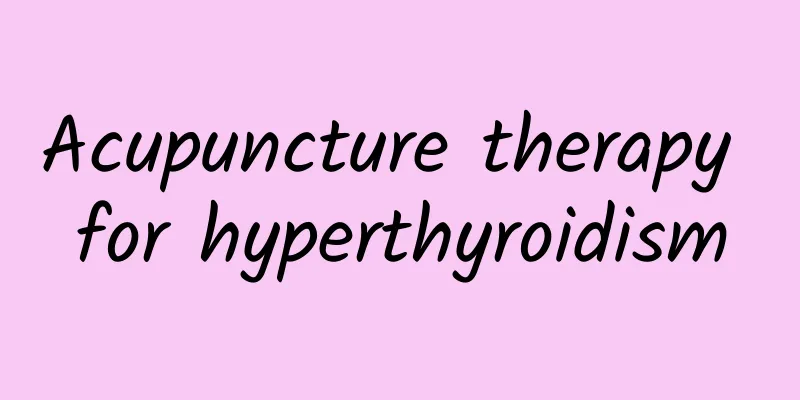Acupuncture therapy for hyperthyroidism

|
This is the 3357th article of Da Yi Xiao Hu 1. Hyperthyroidism Hyperthyroidism, also known as hyperthyroidism, refers to the high-functioning state of the thyroid gland, which is characterized by thyroid enlargement, increased basal metabolism and autonomic nervous system disorders, with palpitations, sweating, increased eating and bowel movements and weight loss as the main symptoms. Clinically, diffuse goiter with hyperthyroidism (Graves' disease) is the most common. This disease is more common in women, with a male-to-female ratio of about 1:4~6. It can occur at any age, but is most common in 20 to 40 years old. Traditional Chinese medicine classifies this disease as "goiter". It is a type of disease caused by emotional injury, improper diet and water and soil, resulting in qi stagnation, phlegm coagulation and blood stasis in the front of the neck, causing lumps and swellings on both sides of the Adam's apple in the front of the neck. "The Treatise on the Causes and Symptoms of Various Diseases·Goiter" says: "Goiter is caused by worry and anger. " The seven emotions hurt the body and insufficient endowment are the main causes of this disease. For example, long-term depression or sudden severe mental trauma can cause the liver's drainage function to malfunction, resulting in liver qi stagnation, qi stagnation and inability to circulate body fluids, which condense into disease, and phlegm and qi block the front of the neck, gradually forming goiter. 2. Main clinical symptoms and diagnosis 1. Weight loss and emaciation, even if the food intake has not decreased or even increased; 2. Emotional agitation, which may lead to anxiety, insomnia, irritability, and lack of concentration; 3. Continuous rapid heartbeat, usually more than 100 times per minute, and the patient may feel palpitations; 4. Excessive sweating and heat intolerance; 5. Most patients may have varying degrees of thyroid enlargement; 6. May be accompanied by exophthalmos, severe vomiting during pregnancy, dizziness and headache; 7. Serum thyroid hormone (T3, T4) levels increase, while thyroid stimulating hormone (TSH) levels decrease. 3. TCM Syndrome Differentiation Traditional Chinese medicine believes that the basic pathogenesis of goiter is qi stagnation, phlegm coagulation, and blood stasis in the front of the neck, so the disease is divided into the following syndromes: 1. Qi stagnation and phlegm obstruction syndrome Swelling in front of the neck, irritability, chest tightness, fullness in the flanks (sides of the chest), sighing (frequent sighing), insomnia, abdominal distension and loose stools, greasy white tongue coating, and a wiry or slippery pulse. 2. Liver fire syndrome Swelling in front of the neck, bulging eyes, irritability, trembling fingers, sweating, flushed face and eyes, dizziness, bitter taste in the mouth and dry throat, constipation, red tongue with yellow coating, and rapid and stringy pulse. 3. Phlegm and blood stasis syndrome A lump appears in the front of the neck, which is hard or has nodules when pressed. The lump does not disappear for a long time, and there is chest tightness, poor appetite (loss of appetite), thin white or greasy tongue coating, and a wiry or astringent pulse. 4. Yin deficiency and hyperactivity of fire syndrome Swelling in front of the neck, bulging eyes, palpitations, sweating, hand tremors, weight loss, dry mouth and throat, hot sensation in the five parts of the body, insomnia and frequent dreams, irregular menstruation, red tongue with little coating, and thin and rapid pulse. 4. Acupuncture Treatment Traditional Chinese medicine takes regulating qi and resolving phlegm, removing blood stasis and dispersing nodules as the basic treatment principle. Acupuncture treatment mainly uses Ashi points, Tiantu, Tanzhong, Zusanli, and Fenglong; Taichong and Neiguan are added for qi stagnation and phlegm obstruction; Xingjian and Qimen are added for liver fire; Zhongwan and Xuehai are added for phlegm and blood stasis; Taixi and Zhaohai are added for yin deficiency and fire excess. 1. Tiantu On the anterior aspect of the neck, in the center of the suprasternal fossa, on the anterior midline. 2. Tanzhong On the chest, at level with the fourth intercostal space, on the anterior midline. 3. Zusanli On the anterior and lateral side of the lower leg, 3 B-cun inferior to the Dubi point, on the line connecting the Dubi and Jiexi points. 4. Hong Leong On the lateral side of the calf, 8 inches above the tip of the lateral malleolus, on the outer edge of the tibialis anterior muscle, one finger width lateral to the lateral opening of the muscle. 5. Taichong On the dorsum of the foot, between the first and second metatarsal bones, in the depression in front of the metatarsal junction, or where the arterial pulse is touched. 6. Neiguan On the anterior forearm, 2 B-cun superior to the distal transverse line of the palmar wrist, between the palmaris longus tendon and the radial flexor carpi tendon. 7. Between the Lines On the dorsum of the foot, between the first and second toes, at the junction of the red and white flesh behind the edge of the toe web. 8. Qimen BL4: BL4 On the chest, in the sixth intercostal space, 4 B-cun lateral to the anterior midline. 9. Zhongwan In the upper abdomen, 4 B-cun above the umbilicus, on the anterior midline. 10. Sea of Blood BL4: On the anterior thigh, 2 B-cun superior to the medial end of the patellar base, on the eminence of the vastus medialis muscle. 11. Taixi : In the ankle region, in the depression between the tip of the medial malleolus and the Achilles tendon. 12. Zhao Hai BL4: In the ankle region, 1 cun inferior to the tip of the medial malleolus, in the depression at the inferior edge of the medial malleolus. operate 1. Moxibustion Moxa sticks can be used for mild moxibustion of qi stagnation and phlegm stagnation and blood stasis. Light one end of the moxa stick and aim it at the acupoints. Smoke and burn 2-3 cm away from the skin until there is a local warm feeling without burning pain. Do this once a day for 15-20 minutes each time. 2. Massage Abdominal acupoints can be massaged in supine or sitting position with the tips of index, middle and ring fingers (such as Zhongwan, etc.), or the acupoints on the limbs can be massaged with the tips of thumbs (such as Xuehai, Zusanli, etc.). 3. Acupuncture Acupuncture points are selected according to different syndromes, with a depth of 0.5-1 inch. Warm needling can be used for some syndromes. Acupuncture must be performed by the doctor himself. 5. Notes 1. Maintain a regular lifestyle and don’t stay up late. 2. Hyperthyroidism patients have an increased basal metabolic rate, so their diet should follow the principle of "three highs and one taboo", and should be high in protein, calories, and vitamins; avoid eating seafood, especially iodine-rich foods such as kelp and seaweed. In addition, avoid drinking strong tea, coffee and other stimulant beverages, and eat less spicy and irritating foods. 3. After diagnosis, actively receive treatment under the guidance of a doctor. Hunan University of Chinese Medicine, School of Acupuncture, Massage and Rehabilitation Professor Chang Xiaorong's team Written by: Xu Xuan, M.S. Supervisor: Professor Chang Xiaorong |
Recommend
Why do my gums swell during menstruation?
During menstruation, due to changes in hormones i...
What are the symptoms of breast hyperplasia
From other aesthetic perspectives, women's br...
Reasons for 15-day menopause
There are always a few days every month that make...
How can girls lose weight quickly?
For girls, having a pair of long and beautiful le...
What is the effect of sour plum soup? How does sour plum soup work to lose weight?
Sour plum soup has very low calories. It can help...
Will anti-inflammatory injections delay menstruation?
Many female friends need to take anti-inflammator...
What to do with leucorrhea before menstruation
Women's first menstruation starts at age 12 a...
What are the obvious symptoms of premature development in girls?
Premature development of girls is actually precoc...
Menstrual period determines the speed of women's aging
The latest research shows that a woman’s menstrua...
Why do I have pain in my cervical spine during menstruation?
Many people often feel uncomfortable cervical pai...
My period is like blood and the color is very light, what's going on?
If women do not maintain good living habits in th...
Will ovulation occur two days after the menstrual period ends?
Menstruation is something women are very familiar...
Pregnant belly with round and pointed belly
What are the differences between a pointed belly ...
RSP report: Social media and young people's mental health
The RSPH (Royal Society for Public Health) has re...
What are the symptoms and treatment of fungal vaginitis?
One of the reasons why the prevention and treatme...









